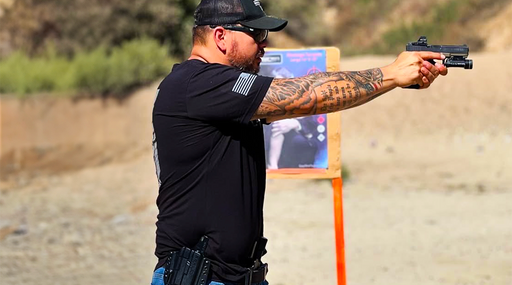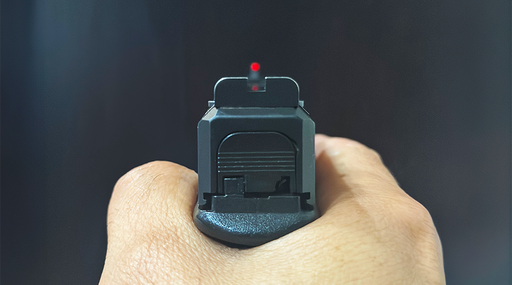There are a lot of new gun owners out there. I’ve been asked about lasers on handguns three times in the last month. So I thought I’d address this topic to the broader audience here at Bravo Concealment. This article is a look at what lasers offer, and their limitations, so you can make an informed purchase and training decision.
Lasers are generally attached to a gun in one of five ways:
• Many sub-compact and micro guns that lack a rail can be outfitted with a laser that attaches, clamshell-style, to the front of the trigger guard. These devices may include a light. They add minimal bulk to the profile of the gun, but can affect holster selection.
• Guns with rails can be fitted with rail-mounted lasers. These vary in size and are often accompanied by a light. Outfitting a gun with a rail-mounted laser will nearly always affect holster choice, unless you’re using a generic cloth holster that’s mostly appropriate for storage only.
• Mounted inside of the recoil spring guide rod, adding nothing to the footprint of the gun and usually being grip-activated.
• Molded into the polymer frame where the accessory rail normally would be. Or, molded into the grip.
• Attached to the grip with a grip sleeve and shining from the grip, same as an integral grip laser. The beams from grip-seated lasers may not reach the target when shooting with the opposite hand that the laser was made for.
Prices for lasers vary widely. The floor is around $100. For a high-quality laser, a few hundred dollars is the norm. This is one product for which prices have been relatively flat or even decreased a bit as technology and competition both rise.
S&W Shield with trigger guard-mounted laser
S&W Bodyguard with integral laser
Reasons to add a laser or purchase a handgun already fitted with one
A laser is an aiming device. At the relatively close distances for which most personal defense pistols are owned, they offer point-and-shoot simplicity.
Lasers can be an effective crutch for people who have vision issues and have problems aligning the sights and attaining a sight picture. Often in this category are the elderly and people who wear distance-focused contacts or glasses, or have had Lasik surgery on their dominant eye. Sometimes people in these categories experience major frustration with using sights. A laser can be of benefit to them.
For people in this category, an always-on or motion-activated red dot sight is usually a better choice than a laser for many reasons. However, lasers are much more available in the current market, and generally less intimidating to use for whatever reason. Also, many handgun instructors are not yet up to speed on red dot selection and use, so good advice and instruction on these devices may be hard to find.
There is no doubt that the more you train with your handgun, the more likely it is you’ll prevail in a deadly force encounter. However, a large segment of the gun-owning population, unfortunately, has no intention of following up on the obligation to train. For them, a laser is probably the safest bet for accurate aim and preventing negligent shot placement. Choosing not to train is, in a way, choosing victimhood for oneself and others.
Limitations of laser sights
There are numerous, potentially serious limitations associated with reliance on a laser for aiming. You know your personal habits and circumstances, so use your judgment in deciding how these factors might apply to you.
• Battery-based operation. Lasers run on batteries. How diligent are you at refreshing the batteries in your home defense flashlight? You have to be confident it’s going to fire up when you need it. Battery life can be affected by the type of switch on your laser. The economy laser that came as a factory add-on with my Ruger LCR .38 Special has an ambidextrous toggle switch that’s really easy to activate. It’s so easy, in fact, that the laser burns itself out inside the soft-sided case that gun lives in. The mere motion of carrying the bag can activate the switch so that when I go to use the laser, it’s dead. This laser is little more than a feel-good marketing gimmick. If you’re already getting the impression that the saying “you get what you pay for” applies to lasers, you’re right.
• Turning on a laser may require training or at least preparation of the device. Depending on the model, some lasers require that the operator perform a specific action to turn the device on. That wastes precious time in a gunfight, and does require practice. There are models that automatically turn on when the hand is placed around the grip. If you’re in that segment of people who want a laser, this more expensive option is the way to go---just be aware that as long as you’re correctly holding the gun, your laser is also marking your location in the dark.
• Sunshine, dust, snow, rain, and lasers are not a good pairing. If you intend to carry your firearm outside the home, be aware that lasers, especially the more common red variety, wash out to the point of invisibility in the sunshine. That effect increases with distance. The maximum effective distance of my red economy laser, with fresh batteries and clean, on a sunny day, is maximum seven yards---and even then I sometimes need to search to find it on the target.
Better-quality, more costly lasers yield a longer range and brighter output. Red lasers are most susceptible to washing out in bright light. Pricier green lasers are hardier. Crimson Trace and Viridian are two companies making reliable lasers in green.
Dust, snow, sweat, sunscreen, lint, fingerprints, and rain, whether they got stuck to the lens before or after drawing the gun, or when moderate to heavy dust or precipitation exists in the environment, can wash out the brightest beam to a soft, weak glow. Whether this matters to you will depend on your anticipated arena of use and storage/carry method.
• Forget distance and precision shooting. Unlike a red dot sight, and despite what Hollywood portrayals of lasers may have you thinking, making a life-saving shot at distance almost assuredly cannot involve a laser, except in total darkness. Making a precision shot at distance requires knowing your laser’s zero and the ballistic performance of your ammunition. Lasers can generally be zeroed quite easily, but the flight path of your bullet can make point of impact quite different than point of aim as distance increases. Most new laser owners are surprised to find the device doesn’t stay perfectly still on target. They end up “chasing” accuracy and being frustrated. A certain amount of psychological preparation for the effect of intrinsic body movement on the laser is necessary for this not to be a distraction.
• Lasers do NOT replace light for target identification. The decision of whether a threat needs to be shot is entirely on your shoulders. Maybe again thanks to Hollywood, many new gun owners are surprised that auxiliary light is necessary for target identification. A laser does NOT light up a target or enhance vision. That’s your job.
There are devices, like the Streamight TLR-6, that incorporate both a light and a laser. The ethical considerations of using a weapon-mounted light are a story for another day; suffice to say a handheld light is preferable for safety reasons but also has its own training requirements.
In conclusion
You’re probably thinking this instructor has a pretty low opinion of lasers as a primary aiming device. You’d be correct. But they are still appropriate for some segments of the gun-owning public as I described at the beginning. Lasers, even inexpensive ones, aren’t cheap. Your hard-earned money is better spent on ammunition and good training. But it’s your money, and whether you buy a laser-equipped gun or not, I hope this article helps you make an informed decision.
Eve Flanigan is a defensive shooting and concealed carry instructor living in the American Southwest. Today she works full time as an instructor and writer in the gun industry. Flanigan loves helping new and old shooters alike to develop the skills needed to keep themselves and their loved ones safe.





















Leave a comment